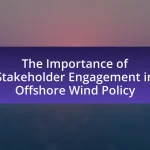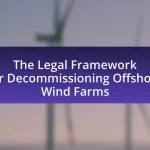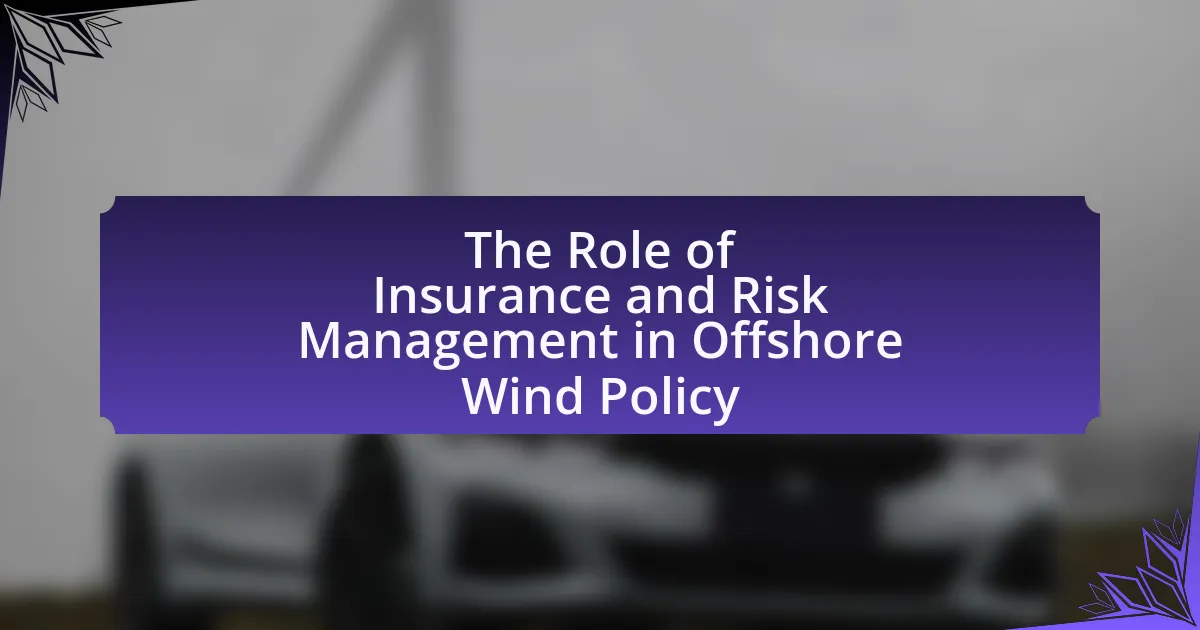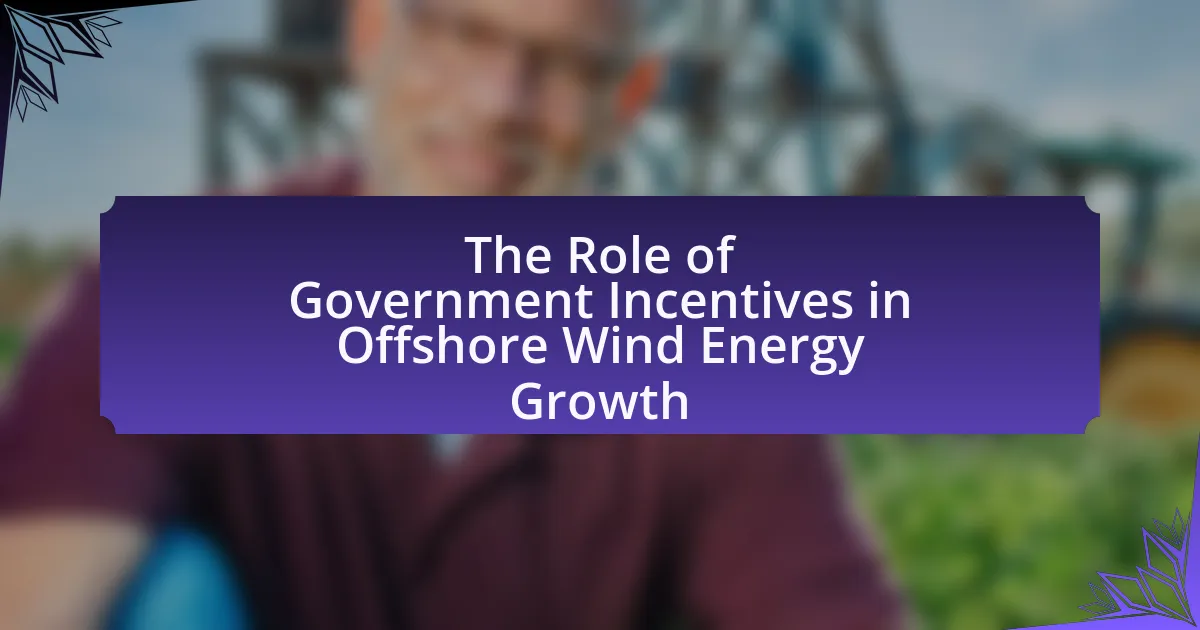The article examines the intersection of maritime law and offshore wind regulations, highlighting the legal frameworks that govern the use of marine spaces for wind energy development. It discusses how maritime law, which includes international conventions and national laws, interacts with offshore wind regulations that focus on permitting, environmental assessments, and safety standards. Key principles such as jurisdiction, safety regulations, environmental protection, and liability are explored, along with the implications for maritime activities and environmental protection. The article also addresses challenges such as jurisdictional conflicts and compliance issues, while emphasizing the importance of collaboration among stakeholders to navigate these complexities effectively. Additionally, it outlines future trends and the role of technology in enhancing compliance and regulatory frameworks.
What is the Intersection of Maritime Law and Offshore Wind Regulations?
The intersection of maritime law and offshore wind regulations involves the legal frameworks governing the use of marine spaces for wind energy development. Maritime law, which includes international conventions and national laws, regulates navigation, shipping, and marine resource management, while offshore wind regulations focus on the permitting, environmental assessments, and safety standards specific to wind energy projects. For instance, the United Nations Convention on the Law of the Sea (UNCLOS) provides guidelines on the rights of states to utilize marine resources, which directly impacts the placement and operation of offshore wind farms. Additionally, countries often require compliance with both maritime safety regulations and environmental protection laws when approving offshore wind projects, ensuring that these developments do not interfere with maritime activities or harm marine ecosystems.
How do Maritime Law and Offshore Wind Regulations interact?
Maritime Law and Offshore Wind Regulations interact primarily through the governance of activities related to the construction and operation of offshore wind farms. Maritime Law provides the legal framework for navigation, safety, and environmental protection in marine environments, while Offshore Wind Regulations establish specific requirements for the development and management of wind energy projects at sea.
For instance, the U.S. Outer Continental Shelf Lands Act governs the leasing of federal waters for offshore wind development, requiring compliance with maritime safety standards and environmental assessments mandated by Maritime Law. This interaction ensures that offshore wind projects do not interfere with shipping lanes and adhere to safety protocols, thereby balancing energy development with maritime interests.
What are the key principles of Maritime Law relevant to offshore wind?
The key principles of Maritime Law relevant to offshore wind include jurisdiction, safety regulations, environmental protection, and liability. Jurisdiction determines which legal framework applies to offshore wind projects, often influenced by the location of the wind farms, whether in territorial waters or on the continental shelf. Safety regulations, such as those mandated by the International Maritime Organization, ensure that offshore installations adhere to standards that protect workers and the marine environment. Environmental protection principles, guided by treaties like the United Nations Convention on the Law of the Sea, require assessments of the ecological impact of offshore wind farms. Liability principles establish accountability for damages or accidents, often governed by conventions such as the Convention on Limitation of Liability for Maritime Claims. These principles collectively shape the legal landscape for offshore wind energy development.
How do Offshore Wind Regulations influence maritime activities?
Offshore wind regulations significantly influence maritime activities by establishing safety zones and navigation protocols around wind farms. These regulations dictate the spatial and operational parameters for vessels, ensuring safe passage and minimizing conflicts between maritime traffic and wind energy installations. For instance, the United States Coast Guard enforces specific navigational rules that require vessels to maintain a safe distance from offshore wind farms, which can alter traditional shipping routes and fishing practices. Additionally, regulations often mandate environmental assessments that impact maritime operations, ensuring that activities such as dredging or anchoring do not interfere with wind farm construction and maintenance. This regulatory framework is essential for balancing the growth of renewable energy with the needs of maritime commerce and navigation safety.
Why is the intersection of these two fields important?
The intersection of maritime law and offshore wind regulations is important because it ensures the legal framework governing maritime activities aligns with the development and operation of offshore wind farms. This alignment is crucial for facilitating investment, ensuring safety, and protecting the marine environment. For instance, maritime law provides guidelines for navigation and safety at sea, while offshore wind regulations address environmental assessments and site leasing. Together, they create a comprehensive regulatory environment that supports sustainable energy development while minimizing conflicts with existing maritime operations.
What are the implications for environmental protection?
The implications for environmental protection in the context of maritime law and offshore wind regulations include the necessity to balance renewable energy development with the preservation of marine ecosystems. Offshore wind farms can disrupt local wildlife habitats, alter water currents, and affect fishing industries. For instance, studies have shown that the construction and operation of wind turbines can lead to changes in fish populations and migratory patterns, necessitating regulations that mitigate these impacts. Furthermore, maritime law must ensure that environmental assessments are conducted prior to project approvals, thereby safeguarding marine biodiversity while promoting sustainable energy sources.
How does this intersection affect maritime safety?
The intersection of maritime law and offshore wind regulations significantly enhances maritime safety by establishing clear guidelines for navigation and operational protocols in wind farm areas. These regulations ensure that vessels maintain safe distances from wind turbines, reducing the risk of collisions and accidents. For instance, the U.S. Coast Guard has implemented specific navigational rules for offshore wind farms, which include designated shipping lanes and safety zones, thereby minimizing potential hazards for both commercial and recreational vessels. This structured approach not only protects maritime traffic but also ensures the safety of workers involved in offshore wind operations, as outlined in the Bureau of Ocean Energy Management’s guidelines.
What are the key challenges at the intersection of Maritime Law and Offshore Wind Regulations?
The key challenges at the intersection of Maritime Law and Offshore Wind Regulations include jurisdictional conflicts, environmental compliance, and safety standards. Jurisdictional conflicts arise because offshore wind farms often span multiple maritime zones, complicating regulatory oversight and enforcement. Environmental compliance is challenging due to the need to balance renewable energy development with the protection of marine ecosystems, which requires adherence to various environmental laws and assessments. Safety standards pose another challenge, as the maritime industry has established protocols that may not align with the specific operational requirements of offshore wind facilities, necessitating the development of new safety regulations tailored to this sector.
What legal conflicts arise between maritime activities and offshore wind development?
Legal conflicts between maritime activities and offshore wind development primarily arise from competing uses of marine space and regulatory jurisdiction. Offshore wind farms can obstruct traditional maritime routes, impacting shipping and fishing operations, which are governed by maritime law. Additionally, regulatory frameworks for offshore wind development often conflict with existing maritime regulations, leading to disputes over permits and environmental assessments. For instance, the U.S. Coast Guard and the Bureau of Ocean Energy Management may have differing priorities regarding safety and environmental protection, complicating the approval process for wind projects. These conflicts necessitate careful navigation of both maritime and energy regulations to balance development with existing maritime interests.
How do jurisdictional issues complicate regulatory frameworks?
Jurisdictional issues complicate regulatory frameworks by creating overlapping authorities and conflicting regulations among different governmental entities. In the context of maritime law and offshore wind regulations, this complexity arises because multiple jurisdictions—such as federal, state, and local governments—may claim authority over the same maritime areas. For instance, the U.S. federal government regulates offshore wind projects through the Bureau of Ocean Energy Management, while state governments may impose additional requirements related to environmental protection and land use. This dual oversight can lead to regulatory uncertainty, delays in project approvals, and increased compliance costs for developers, as they must navigate a patchwork of regulations that may not align.
What are the challenges in compliance with both sets of regulations?
The challenges in compliance with both sets of regulations stem from the complexity and potential conflicts between maritime law and offshore wind regulations. Maritime law often prioritizes navigation and safety at sea, while offshore wind regulations focus on environmental protection and energy production. This dual focus can lead to conflicting requirements, such as differing standards for environmental assessments and safety protocols. Additionally, the jurisdictional overlap can create confusion regarding which regulatory body has authority, complicating compliance efforts for developers. For instance, the U.S. Bureau of Ocean Energy Management and the Coast Guard may have differing requirements that must be simultaneously addressed, increasing the administrative burden on companies operating in this space.
How do stakeholders navigate these challenges?
Stakeholders navigate challenges in the intersection of maritime law and offshore wind regulations by engaging in collaborative dialogue and forming partnerships. This approach allows them to address regulatory complexities, environmental concerns, and logistical issues effectively. For instance, stakeholders often participate in multi-stakeholder forums that include government agencies, environmental groups, and industry representatives to share insights and develop best practices. Additionally, they utilize legal frameworks and guidelines established by organizations such as the International Maritime Organization to ensure compliance and mitigate risks associated with offshore wind projects. This collaborative and informed strategy enables stakeholders to adapt to evolving regulations and enhance project viability.
What role do legal experts play in resolving conflicts?
Legal experts play a crucial role in resolving conflicts by providing specialized knowledge of laws and regulations that govern specific areas, such as maritime law and offshore wind regulations. They analyze legal frameworks, interpret statutes, and offer guidance on compliance, which helps parties navigate disputes effectively. For instance, in maritime law, legal experts can mediate conflicts related to shipping rights, environmental regulations, and contractual obligations, ensuring that all parties adhere to legal standards. Their expertise is essential in facilitating negotiations, drafting agreements, and representing clients in legal proceedings, thereby promoting fair resolutions and minimizing litigation risks.
How can collaboration between stakeholders improve outcomes?
Collaboration between stakeholders can significantly improve outcomes by fostering shared knowledge, aligning objectives, and enhancing resource allocation. When stakeholders, such as government agencies, private companies, and local communities, work together, they can identify common goals and address potential conflicts early in the process. This collaborative approach leads to more informed decision-making and efficient project execution. For instance, studies have shown that projects involving multiple stakeholders often experience reduced delays and cost overruns, as seen in the development of offshore wind farms where coordinated efforts have led to streamlined permitting processes and improved environmental assessments.
What are the future trends in Maritime Law and Offshore Wind Regulations?
Future trends in Maritime Law and Offshore Wind Regulations include increased regulatory frameworks to address environmental concerns and the integration of renewable energy standards. As offshore wind energy projects expand globally, countries are developing comprehensive legal structures to manage maritime activities, environmental protection, and safety protocols. For instance, the European Union’s Green Deal emphasizes sustainable maritime practices, which influences national regulations. Additionally, advancements in technology, such as digital monitoring systems, are being incorporated into maritime law to enhance compliance and enforcement. These trends reflect a growing recognition of the need for cohesive policies that balance maritime interests with the promotion of renewable energy sources.
How is technology influencing the regulatory landscape?
Technology is significantly influencing the regulatory landscape by enabling more efficient monitoring, compliance, and enforcement of maritime laws and offshore wind regulations. Advanced technologies such as satellite imagery, drones, and IoT devices facilitate real-time data collection and analysis, allowing regulators to track environmental impacts and ensure adherence to safety standards. For instance, the use of remote sensing technology has improved the ability to monitor offshore wind farm operations, leading to more informed regulatory decisions. Additionally, data analytics tools help in assessing compliance with regulations, thereby streamlining the regulatory process and enhancing transparency.
What innovations are shaping the future of offshore wind energy?
Innovations shaping the future of offshore wind energy include advancements in turbine technology, floating wind farms, and digital monitoring systems. Turbine technology has evolved to produce larger, more efficient turbines that can generate more energy per unit, with some models exceeding 12 MW capacity. Floating wind farms allow for deployment in deeper waters, expanding the potential for offshore wind energy generation; for instance, the Hywind Scotland project, the world’s first floating wind farm, has demonstrated the viability of this approach. Additionally, digital monitoring systems utilize IoT and AI to optimize performance and maintenance, enhancing operational efficiency and reducing costs. These innovations collectively contribute to the growth and sustainability of offshore wind energy.
How can technology enhance compliance with maritime laws?
Technology can enhance compliance with maritime laws by utilizing advanced monitoring systems, data analytics, and automated reporting tools. These technologies enable real-time tracking of vessels, ensuring adherence to regulations such as navigation safety and environmental protection. For instance, the implementation of Automatic Identification Systems (AIS) allows authorities to monitor vessel movements and detect violations promptly. Additionally, satellite imagery and drones can be employed to oversee compliance with environmental regulations, such as emissions standards and protected marine areas. The integration of these technologies not only improves enforcement capabilities but also fosters a culture of accountability among maritime operators, ultimately leading to better compliance with maritime laws.
What best practices can be adopted for effective regulation?
Effective regulation in the context of maritime law and offshore wind can be achieved through stakeholder engagement, clear guidelines, and adaptive management. Stakeholder engagement ensures that all parties, including local communities, industry representatives, and regulatory bodies, contribute to the regulatory framework, fostering transparency and trust. Clear guidelines provide a structured approach to compliance, reducing ambiguity and enhancing adherence to regulations. Adaptive management allows for the incorporation of new scientific data and technological advancements, ensuring that regulations remain relevant and effective over time. These practices are supported by case studies demonstrating improved regulatory outcomes in similar contexts, such as the successful integration of stakeholder feedback in the development of offshore wind projects in Europe, which led to more efficient permitting processes and reduced conflicts.
How can policymakers create more cohesive regulatory frameworks?
Policymakers can create more cohesive regulatory frameworks by integrating maritime law with offshore wind regulations through collaborative stakeholder engagement. This approach ensures that diverse interests, including environmental, economic, and social factors, are considered in the regulatory process. For instance, the U.S. Bureau of Ocean Energy Management has successfully implemented a framework that aligns offshore wind development with existing maritime laws, facilitating smoother project approvals and reducing conflicts. By fostering inter-agency cooperation and establishing clear guidelines, policymakers can enhance regulatory coherence, ultimately promoting sustainable offshore wind energy development while safeguarding maritime interests.
What strategies can stakeholders implement to ensure compliance?
Stakeholders can implement several strategies to ensure compliance with maritime law and offshore wind regulations, including establishing clear communication channels, conducting regular training sessions, and utilizing compliance management systems. Clear communication channels facilitate the dissemination of regulatory updates and expectations among all parties involved, ensuring that everyone is informed. Regular training sessions enhance understanding of compliance requirements, as evidenced by studies showing that organizations with ongoing training programs experience fewer regulatory violations. Compliance management systems, which track adherence to regulations and provide real-time reporting, have been shown to improve compliance rates significantly, as they allow stakeholders to identify and address potential issues proactively.
What practical steps can stakeholders take to address the intersection of Maritime Law and Offshore Wind Regulations?
Stakeholders can address the intersection of Maritime Law and Offshore Wind Regulations by establishing collaborative frameworks that involve legal experts, industry representatives, and regulatory bodies. These frameworks should focus on harmonizing existing maritime laws with emerging offshore wind regulations to ensure compliance and promote sustainable development. For instance, stakeholders can conduct joint workshops and training sessions to educate all parties on the legal implications of offshore wind projects, thereby fostering a shared understanding of regulatory requirements. Additionally, stakeholders can advocate for the development of clear guidelines that integrate maritime safety standards with offshore wind operational protocols, which can help mitigate risks associated with navigation and environmental protection.




